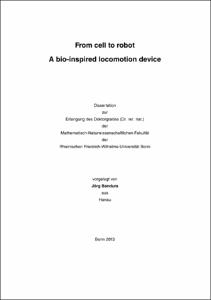From cell to robotA bio-inspired locomotion device

From cell to robot
A bio-inspired locomotion device

| dc.contributor.advisor | Alt, Wolfgang | |
| dc.contributor.author | Bandura, Jörg | |
| dc.date.accessioned | 2020-04-19T19:26:49Z | |
| dc.date.available | 2020-04-19T19:26:49Z | |
| dc.date.issued | 02.05.2014 | |
| dc.identifier.uri | https://hdl.handle.net/20.500.11811/6039 | |
| dc.description.abstract | Bionics or biomimetics is an interdisciplinary research field, a scientific approach to applicate naturally developed biological systems, methods and solutions to the study and design of technology and engineering systems. Therefore bionics is based on an exclusive mutuality between life sciences and technology and its associated sciences, such as robotics. Robots are special artificial agents, and they have much in common with biological agents in case of the need to adapt to their environment. A popular trend in robotics is the development of soft robots – artificial agents with a rather flexible skin or shape, propulsing itself with some type of crawling movement. These robots are able to deform and adapt to obstacles during locomotion, which is an advantage over classical wheeled or legged propulsion. Bionics is helpful in developing locomotion devices for robots, e. g. bio-inspired climbing robots, such as geckobots, utilise the biological gecko adhesion model for climbing. Most of these bio-inspired climbing robots have the disadvantage of using legs for locomotion. The idea is to find a new biological model for a bionic robotic locomotion device that is using an adhesion-dependent crawling locomotion, which allows the robot to climb (or at least be able to master inclinations) and still has a rather soft and deformable shape providing the flexibility of adaptation to obstacles or a changing environment. Surprisingly, single cells, such as amoebae or animal tissue cells, provide these required properties: the ability to crawl on surfaces by formation of adhesion bonds and a very deformable shape – a perfect model for such robots. These cells are reorganising their cytoskeletal cortex and create a visco-elastic gradient which is polarising the cell with a sol-like "sloppy" leading edge at the front and a gel-like "stiff" rear end. This work demonstrates that it is possible to transfer the biophysical locomotion mechanism of cell migration to a simulation model of soft robots, which use an adhesion-dependent mechanism to autonomously create a polarising elasticity gradient during motion. It introduces and analyses three robot models, which are able to move on surfaces with different built-in integrations of this polarisation mechanism. Simulations show that the robots are flexible enough to adapt to changing environments, such as rough surfaces. One model is even able to crawl on walls and ceilings against the direction of gravity. Finally, this work offers some ideas for possible constructions and usability of these robots, and what insights their analysis might give into principles of biological cell migration. | |
| dc.language.iso | eng | |
| dc.rights | In Copyright | |
| dc.rights.uri | http://rightsstatements.org/vocab/InC/1.0/ | |
| dc.subject | Bionik | |
| dc.subject | Biomimetik | |
| dc.subject | Zellmigration | |
| dc.subject | Robotik | |
| dc.subject | Modellierung | |
| dc.subject | Zellbiologie | |
| dc.subject | Theoretische Biologie | |
| dc.subject | Simulation | |
| dc.subject | Simulationsmodell | |
| dc.subject | Rechnersimulation | |
| dc.subject | bionics | |
| dc.subject | biomimetics | |
| dc.subject | cell migration | |
| dc.subject | robotics | |
| dc.subject | modelling | |
| dc.subject | cell biology | |
| dc.subject | theoretical biology | |
| dc.subject | simulation model | |
| dc.subject.ddc | 500 Naturwissenschaften | |
| dc.subject.ddc | 570 Biowissenschaften, Biologie | |
| dc.subject.ddc | 600 Technik | |
| dc.title | From cell to robot | |
| dc.title.alternative | A bio-inspired locomotion device | |
| dc.type | Dissertation oder Habilitation | |
| dc.publisher.name | Universitäts- und Landesbibliothek Bonn | |
| dc.publisher.location | Bonn | |
| dc.rights.accessRights | openAccess | |
| dc.identifier.urn | https://nbn-resolving.org/urn:nbn:de:hbz:5n-35142 | |
| ulbbn.pubtype | Erstveröffentlichung | |
| ulbbnediss.affiliation.name | Rheinische Friedrich-Wilhelms-Universität Bonn | |
| ulbbnediss.affiliation.location | Bonn | |
| ulbbnediss.thesis.level | Dissertation | |
| ulbbnediss.dissID | 3514 | |
| ulbbnediss.date.accepted | 19.12.2013 | |
| ulbbnediss.fakultaet | Mathematisch-Naturwissenschaftliche Fakultät | |
| dc.contributor.coReferee | Baumgartner, Werner |
Dateien zu dieser Ressource
Das Dokument erscheint in:
-
E-Dissertationen (4118)




